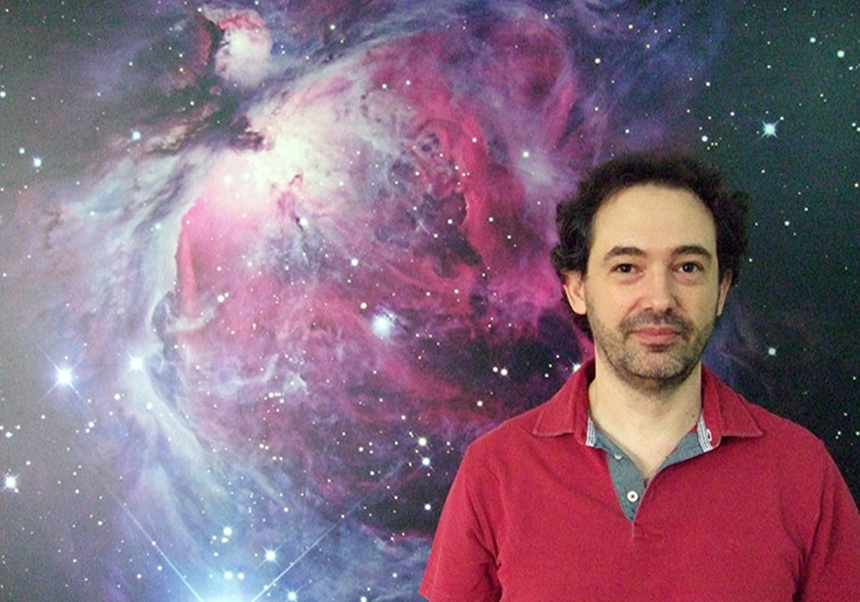
Mauro Stefanon, CIDEGENT researcher at the Department of Astronomy of the University of Valencia, has just been awarded a Consolidator Grant (ERC) to develop an ambitious project that will allow a significant leap in the understanding of the early formation of galaxies. His work, carried out with the help of the James Webb telescope, will provide new information about massive galaxies in the first billion years after the Big Bang.
Around us, in the so-called Local Universe, it is possible to observe galaxies up to one hundred times larger than the Milky Way. They are made up of billions of stars and science wonders about their origin, about their formation. Until recently, certain instrumental limitations prevented a solid reconstruction of the physical properties and history of distant galaxies, that is, those that are observed as they were in the first billion years after the Big Bang when the Universe was very young. But in 2021 the launch of the James Webb Space Telescope (JWST) – of exquisite sensitivity and enormous spatial resolution – triggered a true revolution by providing the first data on very massive galaxies observed in the first 400/500 million years of the history of the Universe. They are, quite likely, the progenitors of these giant galaxies existing in the nearby universe. The evidence is so great that not even the most optimistic forecasts of theoretical models clearly justify its abundance. Understanding how they could form constitutes one of the most important challenges in astrophysics.
Mauro Stefanon, CIDEGENT researcher at the Department of Astronomy and Astrophysics of the University of Valencia, has just been awarded a Consolidator Grant worth almost two million euros to continue working in this field for the next five years. The grant will be aimed at improving the understanding of the early formation of galaxies, and specifically the most massive galaxies, based on new data from the James Webb telescope. Direct observation of it generates expectations among the scientific community, since, often, the strangest objects have the potential to generate transformative advances in the understanding of Nature.
SFEER (Star Formation Efficiency in the Epoch of Reionization) – as the project funded by the European Research Council (ERC) is called – will probe the formation of galaxies from the earliest points in cosmic time; It will characterise their ages, their stellar masses and their content of chemical elements – that is, their metallicity – as well as the kinematics of the interstellar gas; and will analyse the relationship of these star systems with the dark matter halos that house them.
“This is the first integrated field spectroscopic data obtained with the James Webb for this type of object. These are data that allow us to study how the spectral properties change throughout each galaxy. This will help us locate the regions with the most gas content, which is the fuel for star formation, and will allow us to distinguish between regions with populations of young massive stars and regions with populations of stars that were formed a long time ago”, says Mauro Stefanon.
In fact, an international team with the participation of the University of Valencia recently identified, thanks to this valuable tool that is the James Webb, a population of massive galaxies candidates to be part of the early universe. The work, published in Nature in early 2023 and co-signed by Stefanon himself, shows the enormous potential of this space observatory.
In search of the origin of the Reionization Epoch
SFEER also plans to advance the identification of high-energy regions during the process after the formation of the first galaxies after the Big Bang. “These could have been the engine of the reionization of intergalactic hydrogen that gave way to the Epoch of Reionization, the last great phase transition of the cosmos”, comments the scientist from the University of Valencia.
It is known that, at that time, the Universe was formed mostly by hydrogen and neutral helium, but that after a billion years the intergalactic hydrogen was already ionised, a fact that resulted in a universe that was more transparent to ultraviolet light. “Characterising these regions is important, since it is suspected that the youngest stars in the most massive galaxies could have created giant spheres of ionised hydrogen in the surroundings of the host galaxies, contributing significantly to this important transition in the Universe”, concludes Mauro Stefanon.
The implementation of the SFEER project during the initial phases of the scientific life of the James Webbs telescope will maximise the research results of both the SFEER program itself and the JWST mission itself, and will advance research with the recently launched Euclid – wide field space telescope –, from the European Space Agency, and the future Nancy Grace Roman Space Telescope from NASA. The James Webb Observatory is the result of collaboration between the US (NASA), European (ESA) and Canadian (CSA) space agencies.






